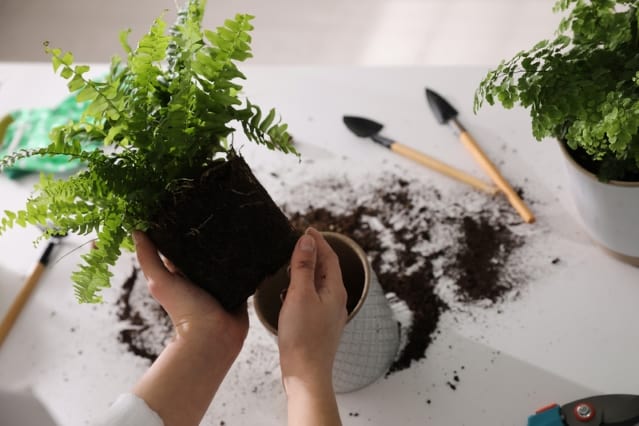
Having a potted fern can be a beautiful addition to your home. As with all house plants, you’ll occasionally need to repot ferns into a larger pot to allow the roots more room to grow and give them fresh and nutrient-rich soil. How often each fern should be repotted varies by the variety, but there are some good rules of thumb.
Ferns should be repotted every two to three years, but each year the roots should be checked to ensure they don’t get too tangled or crowded inside the pot. Overcrowding of the roots can stunt root and rhizome growth, and soil will need to be replaced to replenish the nutrients.
If your fern is beginning to look tired, or growth is slow, increasing to the next pot size should help it bounce back. Repotting is quick and easy if you follow a few simple steps.
Why You Need to Repot a Fern and How Often You Should Do So
Best practice is to check on your fern’s roots at least once every year, and repotting should be done once every two to three years. Sometimes, certain environmental conditions such as not enough light exposure, temperatures that are too high or too low, or overwatering, may cause your fern to wilt or begin to die. Although it is important to identify the problem that is affecting your fern, repotting can give it the best chance for recovery.
You should repot your fern when you notice the roots are crowding, because the roots and rhizomes will be unable to expand further and the nutrients in the soil can be exhausted. When it becomes too crowded, the roots will get tangled and will have a hard time growing and expanding. If the soil runs out of the necessary nutrients to keep the fern sustained, grow will falter and the plant will eventually begin to die.
When repotting, you’ll need to go up one pot size so there is adequate room for it the roots to spread out into the free soil.
Checking for Signs You Need to Repot the Fern
The biggest indication that it is time to repot your fern is that the roots have become overcrowded. You can use your fingers to dig at the soil a bit around the edges of the pot and try to get a good look at the roots to see if they’ve started to crowd or circle around the edges of the pot. If it’s hard to tell, check for crowding by bringing your potted fern outside, and then carefully sliding the plant out of the pot.
Once you have it out of the pot, you’ll want to get a good look at the soil around the edges. Sometimes, you can still see the roots through the soil without shaking off any of the soil. If the roots are exposed from the soil and look crowded and tangled around the edges, like they didn’t have much room to expand, you will likely need to repot it.
If there is still a pretty big layer of soil around the roots, place the fern back in its original pot. It will be fine to wait another year to repot.
Ideal Soil and Environment

The best type of soil for your fern is organic potting mix soil that is acid or neutral, with balanced nutrients, and plenty of coarse material for good drainage. These types of soil mixes will also be able to hold just enough water to not drown your fern while still being able to drain just the right amount. The pot should also have a drainage hole at the bottom for excess water to escape. This type of soil will ensure a longer life for your fern and prevent you from having to repot more than once per year.
Another thing to pay attention to in order to ensure that your fern is healthy and cared for is its environment and maintenance. The environment and maintenance include factors like light exposure, temperature, and humidity.
When it comes to light, you should avoid placing your fern in direct sunlight so the fronds don’t get sun-bleached or scorched, but you’ll want to position it based on the needs of the variety. If your plant tag says that your particular fern variety can handle shade or less sunshine, you can place it deeper in the room, but other varieties do well on windowsills (except for south facing windows). Finally, ensure that your fern gets plenty of extra moisture if it is placed in brighter sunlight.
You should also pay attention to the temperature and humidity of your home, as they should be similar to the outdoor environment that ferns are used to. Most popular indoor varieties are tropical fern species, so you’ll want the temperature of your fern’s environment to be somewhere between 65 and 75 degrees Fahrenheit. Keep them away from air vents or doors where drafts of air can affect them. You’ll also want to ensure that your fern gets plenty of humidity, especially if you live in a dryer climate.
Keeping your fern next to a water source like the kitchen or in the bathroom can help your fern get more moisture. If you want to keep your fern somewhere else, you can fill a tray with a layer of pebbles and add some water, then place your pot on top. The fern will absorb the moisture as the water evaporates. Continue to add water to the tray to ensure your fern gets the moisture it needs.
How to Repot a Fern

Here’s what you will need to do to repot your fern:
- Have the following things ready: the fern, the new (larger) pot with a drainage hole, the right organic soil, and drainage material such as drainage stones.
- Line the bottom of the new pot with the drainage material to allow for adequate draining.
- Remove the fern from its current pot by gently grasping the plant by its stems and giving it a gentle tug, turning it on its side. If it doesn’t budge, you can use a spade to break the soil away from the pot edges to dislodge it.
- Give the roots a bit of a massage and transport them to their new pot.
- Pack the new soil around the plant’s ball of roots and fill up the entire container with fresh soil so the plant can stand straight up. Make sure the soil is compact.
- Pour a bit of water into the fern’s new home, then clean up any soil or mess around your workplace.
Caring for Your Fern
You’ll want to continue to care for your fern by watering, occasional fertilizing, and grooming it. When it comes to watering, make sure that the soil is always damp but not waterlogged or soggy. Whenever the top feels dry, you’ll need to water it again.
If you want very luxuriant growth you can feed your fern with fertilizer during its growing season, but most varieties can manage fine without. Organic indoor liquid plant food, which you can find at your local garden center, should be diluted by half, and check the label for a brand with balanced nutrients.
Repotting is a part of routine maintenance for ferns, and an annual check for crowded roots is recommended. Typically, repotting every two to three years is ideal for most varieties.
